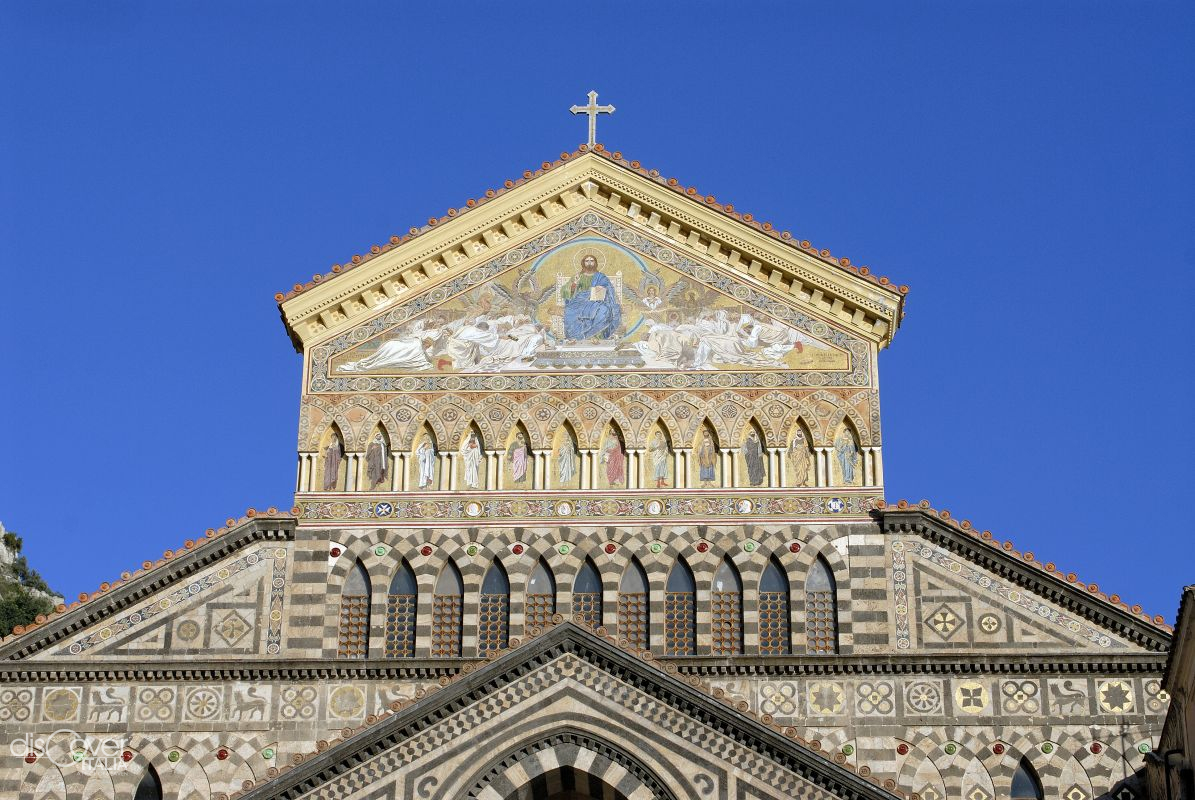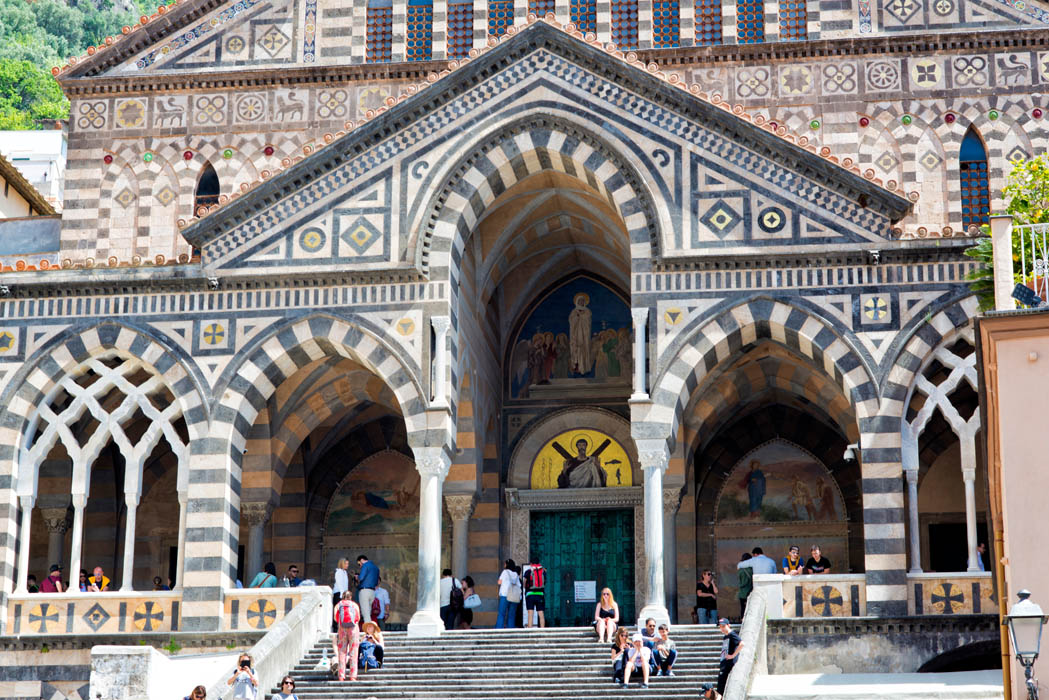Fifty-seven steps leading to the most famous and visited monument
 The beautiful and majestic Cathedral of Amalfi summarises, in the variety of styles and inspirations, the mediterranean vocation, which has made a small town great in history, squeezed between the sea and the rugged rocks of the coast. In that area, well visible from the sea, an Early Christian basilica rose from the 6th century on whose ruins, three centuries later, at the beginning of the advent of the Republic, the new cathedral of Amalfi was built, dedicated to Our Lady of Assumption (Madonna Assunta), first patron saint of the city, and to the Saints Cosmas and Damian, with three naves and in Romanesque style.
The beautiful and majestic Cathedral of Amalfi summarises, in the variety of styles and inspirations, the mediterranean vocation, which has made a small town great in history, squeezed between the sea and the rugged rocks of the coast. In that area, well visible from the sea, an Early Christian basilica rose from the 6th century on whose ruins, three centuries later, at the beginning of the advent of the Republic, the new cathedral of Amalfi was built, dedicated to Our Lady of Assumption (Madonna Assunta), first patron saint of the city, and to the Saints Cosmas and Damian, with three naves and in Romanesque style.  A little more than a century later, in 987, Amalfi, rich and powerful, by decision of Duke Manson I, started the construction of another cathedral, dedicated to the new patron saint, Saint Andrew the apostle. The two neighbouring churches were united and a six-naved Romanesque temple was created. Embellished in 1060 by a valuable bronze door made in Constantinople by the will of the Amalfi merchant Pantaleone de Comite Maurone. In 1266, the great church changed to five naves, when one of the three of the oldest edifice was sacrificed for the creation of the cloister of Paradise (Chiostro del Paradiso), another architectonic contribution to the complex of the cathedral, where in the Thirteenth century elements of the new Arab-Norman style started appearing, clearly visible in the twisted columns of the transept. And on the famous and unique two coloured facade, where the Moorish patterns with other Neo-gothic are the result of a nineteenth century restoration which, after a collapse, led to an elimination of the addition, especially the Baroque ones, in order to recover the original version. The tympanum mosaic is of great impact, representing the Triumph of Christ, of Domenico Morelli. Although in the rest of the building, there were many changes during different eras, until the decisive Baroque transformation of the seventeenth century, which had covered some of the original characteristics.
A little more than a century later, in 987, Amalfi, rich and powerful, by decision of Duke Manson I, started the construction of another cathedral, dedicated to the new patron saint, Saint Andrew the apostle. The two neighbouring churches were united and a six-naved Romanesque temple was created. Embellished in 1060 by a valuable bronze door made in Constantinople by the will of the Amalfi merchant Pantaleone de Comite Maurone. In 1266, the great church changed to five naves, when one of the three of the oldest edifice was sacrificed for the creation of the cloister of Paradise (Chiostro del Paradiso), another architectonic contribution to the complex of the cathedral, where in the Thirteenth century elements of the new Arab-Norman style started appearing, clearly visible in the twisted columns of the transept. And on the famous and unique two coloured facade, where the Moorish patterns with other Neo-gothic are the result of a nineteenth century restoration which, after a collapse, led to an elimination of the addition, especially the Baroque ones, in order to recover the original version. The tympanum mosaic is of great impact, representing the Triumph of Christ, of Domenico Morelli. Although in the rest of the building, there were many changes during different eras, until the decisive Baroque transformation of the seventeenth century, which had covered some of the original characteristics.

It was after those interventions that the definitive separation happened between the cathedral of Saint Andrew and the pre existing one, which took the name of Basilica of the Crucifix with a wooden Crucifix from the fourteenth century standing out on the apse.
The marble covering, the altars, the ceiling and the ceiling coffers date back to the Baroque transformation of the Dome. On the pre-conciliar main altar, there is a copy of the local author of Crucifixion of Saint Andrew the apostle of Mattia Preti. In one of the two chapels, there is the wooden sculpture of the Apparition of Saint Michel to Saint Fedele. On the ceiling, the Stories of Saint Andrew are painted with gold decorations. The reliquary statue of the patron saint is kept in the left aisle, while the statue carried in the procession is in the sacristy. And in the chapel of the Reconciliation, there is the reliquary of Saint Andrew’s head.
On the 8th of May 1208, a solemn ceremony welcomed the remains of the apotle in the Cathedral of Amalfi, and were then brought back to the East by Cardinal Pietro Capuano, of noble Amalfi origin, who had participated to the crusade as a legate of Pope Innocent III. The Crypt of the cathedral was built on the new grave of the apostle, where the Arrival of the body of Saint Andrew in Amalfi is represented in a fresco by Aniello Falcone of 610, where you can see the Romanesque cathedral ad how it used to be in the thirteenth century. On the seventeenth century altar, there is a bronze statue of Saint Andrew by Michelangelo Naccerino, with the marble statues of the martyr Lorenzo, of Pietro Bernini, father of the famous Gian Lorenzo, and of Saint Stephane.

Regarding the Basilica of the Crucifix, a restoration of 1931 has recovered the medieval plan to which the pointed arches belong, the double arched-windows and the single lancet windows, with the frescoes from the Angevin period, including a Madonna with child, the saint Cosmas and Damian, the Blessed Gerard Sasso, the founder of the Order of Saint John of Jerusalem, then of Malta, by an artist from the entourage of Pietro Cavallini. The ancient church houses the Cathedral Museum of Sacred Art, with the Treasure of the Cathedral, made of liturgical objects and sacred vestments of great value, including an Angevin miter and an enameled chalice from the fourteenth century.
The Cloister of Paradise (Chiostro del Paradiso) is connecting the Cathedral with the Basilica of the Crucifix. The cloister is the cemetery of the nobles built between 1266 and 1268, and appears as a quadriporticus with pointed arches interlaced in Arabic-Normand style supported by sixty small columns. In the southern part of the cloister, there are six frescoed noble chapels, in which you can see the Crucifixion attributed to the school of Giotto.
In front of the cloister the Campanile rises, built between 1108 and 1276, in Romanesque style, but with the bell cell of Moorish style.

Like, for exemple the Church of Saint Anthony, in Capo di Croce neighbourhood, which the tradition tells that it was founded as the church of Santa Maria degli Angeli, together with the adjoining convent, in 1220 by Saint Francis, who came to Amalfi to honor the tomb of Saint Andrew. Of the Franciscan complex, the beautiful cloister is open to the public only in the afternoon on 13th of June for the feast of Saint Anthony, while the church is temporarily closed for renovations. The church has a single nave and old statues of the Franciscans saints (now transferred to the cathedral), a significant sixteenth-century canvas illustrating the Marriage of Mary and Joseph on the main altar and a much venerated painting of the Madonna of Carmine. Inside, there is also a small crypt, corresponding to the oldest nucleus of the convent, frescoed with scenes of Saint Francis life.

From Porta della Marina, next to which you can admire the ceramic panel by Renato Rossi dedicated to the commercial success of Amalfi, you are at the entrance of the Ancient Arsenal, where the galeas of the war fleet of the Republic were constructed. It is the only Medieval arsenal still standing in the South, although the whole part directly connected to the sea is lost, only two lanes separated by ten pillars remain, perfectly restored, which house the Museum of the Compass and the Maritime Duchy of Amalfi with ancient navigation instruments and precious finds of the maritime history of the city, first of all the Tabula de Amalpha. There is also the galleon participating in the four-year regatta of the Maritime Republics.
Not far from the Arsenal, once Piazza dei Dogi reached, along the Salita San Nicola dei Greci, you get to Rione Vagliendola, which preserves the characteristic architectural identity of Amalfi in the edifices and in the alleys, some of which with magnificent views of the sea. The remains of the ancient church of San Bartolomeo are of considerable importance, as well as a Domus from the 12th century. You can go up to Largo Spirito Santo for a visit to the Paper Museum (Museo della Carta), fundamentally to know Amalfi, and from there you can continue to Valle dei Mulini. From the western gateway of the town, the “Vallenula”, you are on the wonderful Via Annunziatella, which takes its name from a small chapel dedicated to Ss. Annunziata where a painting of the Annunciation of the archangel Gabriel to the Virgin Mary is venerated. It is a path of great visual impact due to the beauty of the panorama it offers at every sigle step. Without forgetting the church of San Nicola dei Greci or of San Biagio, from the 11th century, seat of the archconfraternity of Ss. Trinità, with a barrel-vaulted nave with sixteenth-century paintings and a nineteenth-century bell tower in Moorish style among the symbols of the city. Continuing the way on Via Annunziatella, you arrive at Albergo dei Cappuccini, originally a convent of 1212, founded by the cardinal Capuano, with the church of San Pietro della canonica, which shows a cloister of rare beauty and a flowered terrace on the coast able to conquer the travelers of all times.
Copyright video, foto e testi © 2020




Comments powered by CComment